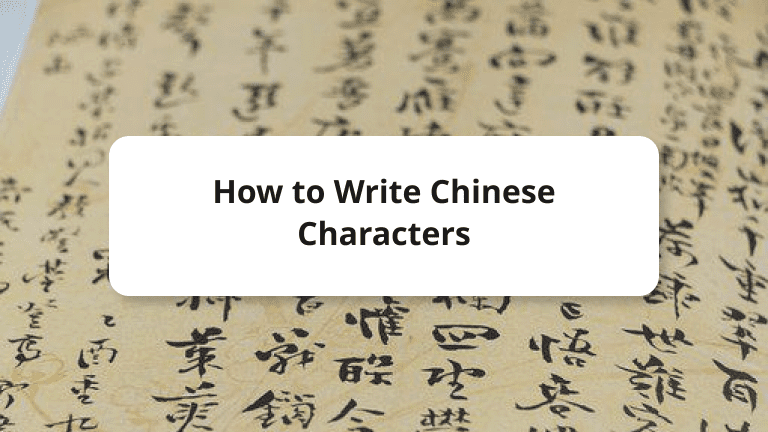Is learning Chinese characters really that important? The answer is yes. Without knowing Chinese characters, you are not able to read and write in Chinese. Although pinyin is used to demonstrate how a Chinese character is pronounced, it is only used when you type, and it isn’t commonly seen in daily life. Also, names in Chinese are composed of Chinese characters. Thus, even if you are good at listening and speaking, it is still particularly important to recognize Chinese characters.
Each Chinese character has its own meaning and pronunciation. From the very beginning, Chinese characters are made and transformed from drawings, and as time went by, six main principles were made to create characters. So, it could be overwhelming in the beginning, but as you continue to learn, you will eventually find out that there are certain rules for you to follow.
In the following section, we are going to talk about some basic rules and principles of Chinese characters.
Table of Contents
Traditional v.s. Simplified Chinese
Traditional Chinese characters have a long history, developed throughout thousands of years, and are commonly used in Taiwan, Hong Kong, and Macau. On the other hand, Simplified Chinese characters were created more recently, transformed from traditional Chinese, and intended to make Chinese characters easier to learn and remember. While simplified Chinese is sometimes criticized that it has lost some original beauty and meaning from traditional characters, due to the massive population using it, simplified Chinese is still more popular in the world than traditional Chinese. Let’s see some examples of the difference between them:
| Simplified | Traditional | Pinyin | English |
|---|---|---|---|
| 准备 | 準備 | zhǔn bèi | to prepare |
| 面条 | 麵條 | mìan tíao | noodles |
| 头发 | 頭髮 | tóu fǎ | hair |
| 出发 | 出發 | chū fā | to depart |
| 爱情 | 愛情 | aì qíng | love |
In the table above, we can see that some commonly used and complicated characters are transformed, but not every one of them. For most transformations, it is just the simplification of the ‘strokes’ (which we will talk about later), and not creating a new character.
Character Formation
Strokes
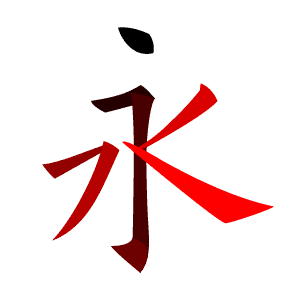
To write Chinese characters, the strokes are the first things you need to learn about. Chinese characters might look complicated and just like drawings, but in fact, all Chinese characters are composed of these strokes, big or small, up and down, left or right. So, it is essential to make sure that you understand these strokes.
Here are some basic and essential strokes that you need to know:
“一”(横): A horizontal line that is written from left to right
“丨”(竖): A vertical line that is written from up to down
“丿”(撇): A beveling line that is written from up-left to down-right
“㇏”(捺): A beveling line that is written from up-right to down-left
“丶”(点): A short beveling line that is written from up-left to down-right
“乛”(折): A “一”(横) ends with a downwards angle on its right end
“㇀”(提): A short beveling line that is written from down-left to up-right
Knowing these strokes will help you to understand how a Chinese character is formed and helps you write them more neatly and easily.
In Chinese calligraphy, there is a basic practice which is called “’永’字八法”, which means the eight strokes to write “永”. Strokes in the character “永” contain the most used strokes, and it is believed that if you can’t master calligraphy without mastering writing this character.
Radicals (部首 bùshǒu)
Another essential principle in Chinese characters is radicals. The concept of radicals is an essential part of characters. It comes from the historical formation of characters, and it tells us what the characters relate to. You can think of the concept of radicals as a kind of categorization. So, when you see a new character, you can try to find its radical and there will be a clue about what the character means.
For example, “口“(kǒu) is mouth and is also a commonly seen radical. “吃”(to eat) and “喝“to drink) are both actions that are related to your mouth, thus you can see a small “口“ on the left, as their radical.
Another good example is when we use “雨“ as a radical. “雨” means rain, thus most weather-related characters have “雨“as their radical. “雾“ means fog, and “雷” means thunder. So, when you see a character with a small “雨“, you can assume it is weather-related.
Here are some other commonly seen radicals:
| Radical | Written Formation | Pronunciation | Meaning | Example |
|---|---|---|---|---|
| 水 | 氵 | shuǐ | water | 河(hé)-river |
| 火 | 灬/火 | hǔo | fire | 烧(shāo)-burn |
| 木 | 木 | mù | wood | 树(shù)-tree |
| 心 | 忄/心 | xīn | heart | 情(qíng)-love |
While learning more about radicals is a good way to understand how Chinese characters are formed, as a beginner of the language, knowing the radicals are convenient for you to remember the meaning, pronunciation, and other related characters.
Types of Chinese Characters
While the very beginning of Chinese characters is visualization, it is impossible to draw everything down and transform them into characters. Thus, with the need for more characters to describe things, there are more types of principles for the formation of characters are made. There are six types of Chinese Characters, but two of them are not often seen. In this section, we are going to introduce some basic types of Chinese character formations, so it is easier to understand and guess how the character is pronounced.
1. Pictographs
Pictograph is the most basic type of Chinese character formation, which means to mimic things by their shape. For example, the word sun, in ancient Chinese, is figured by a dot in a circle, now with years of evolution, now it becomes the character “日“. The characters in this formation are usually natural things, animals, and sometimes tools that have existed for ages. Other commonly seen pictographic characters are“火“(fire), “牛”(cow), “川”(river), “山“(mountain).
The limitation of this formation is that it only describes things with visible shapes or forms, and therefore we need other types of characters.

2. Pictophonetic characters
Pictophonetic means shape and sound. In this type of character, shapes are usually the radicals, which give you the concept of what the character is related to. And the sound is the other part, usually another character, which gives you a hint of how the character is pronounced. “期“(Qí) is a good example of pictophonetic characters. There is a “月“ in the character, which means moon. As a radical, it means that the character is related to the lunar calendar. The “其“(Qí) on the left implies the pronunciation of the character.
The tricky part of this type of character is that the meaning part could be in the upper, lower, left, or right of the character, so it is very important that you recognize the radical in the character.
The other commonly seen pictophonetic characters are “妈“(mother), “爸“(father), “奶”(grandmother), “爷“(grandfather).
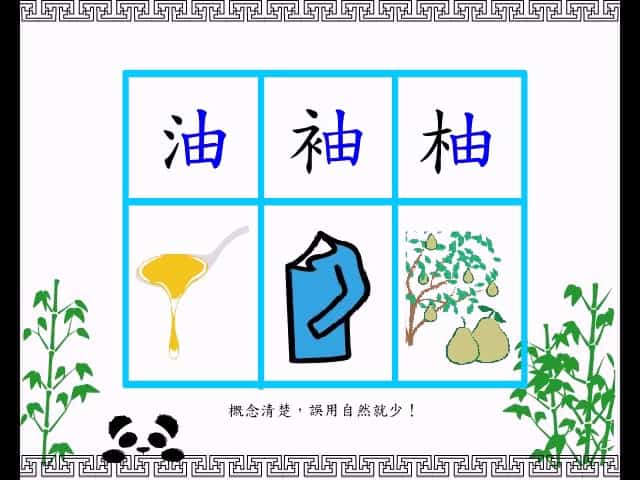
3. Simple ideograms
This type of character is the demonstration of some simple concept. This type of character indicates some things that cannot be pictorialized, for example, numbers in Chinese. The Chinese character for the number one is “一“, and “二” is for the number two. The ideogram in these two characters is easy to understand.
Another good example of this type of character is “上”, the character for “up” and “above”, and “下“, the character for down.
There are not many characters in this type of formation.
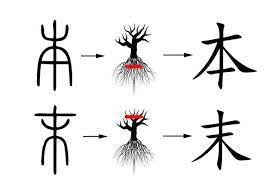
4. Compound ideographs
A compound ideographic character is made up of two or three parts, putting pictographic or ideographic characters together to indicate what the character means. For example, the character of “rest” is “休“, which is composed of a person on the left and a tree on the right, giving the image of a person leaning on a tree to rest.
Another example is “明“, the character for “bright”, it contains the characters of sun on the left and a moon on the right, the two elements which make the world bright.
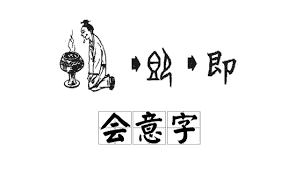
Tips on How to Write Chinese Characters

Learning how to write Chinese characters is definitely a challenge for Chinese learners. Some of them are composed of complicated strokes, which makes them hard to be memorized. It is also important to follow the order of the strokes since it helps you to write neatly. With all the complexity, it is sometimes for others to read if you have bad writing.
Furthermore, it is very important to choose the right character for the word. Choosing the wrong character could make no sense or bring a wrong meaning to the word and leads to misunderstanding.
So, here are some tips for you to memorize:
1. Visualize the Characters
For some characters that are not so complex and are not composed of other characters, you can try to visualize the characters.
For objects, try to imagine or look up how the character is transformed, and for abstract concepts, try to think about how the character is indicating the meaning of it.
For pictographic and simple ideographic characters, it will be easier to understand how they are transformed.
2. Breakdown the words
When you start to learn characters that are more complicated, try to break down the words.
For pictophonetic characters, there is a saying that “pronounce the word by its left or right component, if there is not, pronounce it by the middle component”. It means you can assume how the character is pronounced by its components.
For compound ideographic character, it might be more difficult to remember than pictophonetic characters, but by breaking down the words, you can easily understand what the character stands for, and memorize it by the meaning.
3. Learn Easier Characters First
Remember, it is definitely easier to learn from characters that are less complicated. Start with easier characters, and memorize their meaning and order of strokes.
Take your time expanding the number of characters, and don’t forget to compare new characters to the old ones you have learned. Try to figure out the rules and similarities, and you will find it easier to understand and remember.

Start Learning Chinese Today!
If you are interested in Chinese characters, why not learn them with a qualified tutor?
AmazingTalker is an online tutoring platform that helps you match with high-quality tutors that fit you the most! Having a tutor gives you chance to learn Chinese in a more structured way, and with help from AmazingTalker, you can learn at the time and place of your choice, which gives you a better learning experience.
A 50-minute lesson from Amazing talker costs from $18-$25, based on the experience of the tutor and the course you choose. One of the good services from AmazingTalker is that you don’t have to sign a time contract with them, you just have to pay for classes that you have done.
So, if you want to try learning Chinese, it is recommended to book a 25-minute trial lesson. A trial lesson cost $6-10, and it gives you an insight into what learning Chinese is like.
Learning Chinese Characters is Fun!
In this article, you learned fundamental knowledge and principles of Chinese characters.
Of course, it is impossible to introduce the whole concept in an article, and learning Chinese characters takes a lot of time and effort. Even Chinese native speakers spend a lot of time in schools trying to learn all the characters and practice writing them.
But don’t let the complexity take you away! Though it is difficult to start at first, after you find out the rules, it will be fun and helpful to know how to write Chinese characters. So, if you would like to learn it in a more systematic way, or you don’t know how and where to start, don’t hesitate to enroll in an online Chinese course.
So, if you are interested, check out AmazingTalker today, and see which Chinese tutor can help you out!
